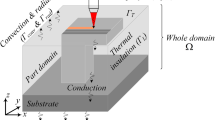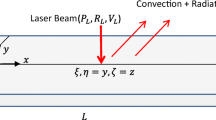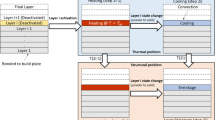Abstract
Thermal distortion and residual stresses are two important factors that affect the quality and reliability of steel parts manufactured by laser powder bed fusion (LPBF) processes. A cost-effective model for evaluation of those heat effects is needed to refine the manufacturing process and provides insights into the product design and heat treatment. In this study, the layer heating method and sophisticated track-layer scanning method were applied to simulate the thermo-mechanical response of IN625 tube parts built by LPBF. Based on the similarity of temperature field in each layer deposit, a swept mesh was constructed to perform the thermal analysis for top layer, with the rest of layers referring to the temperature by node number offsetting. A novel explicit finite element analysis code accelerated by graphics processing unit was used for the massive-element numerical analysis. The computational accuracy and efficiency of the layer heating and track-layer scanning methods were compared in detail. It is shown that layer heating method can efficiently capture the pattern of stress distribution with reasonable accuracy in stress magnitude. The grouped track-layer scanning method can predict the residual stress and strain more accurately at a higher cost (5 ~ 10×). The elastic strain distribution was compared with the measurement by X-ray diffraction, confirming the accuracy of residual stress prediction.











Similar content being viewed by others
References
Frazier WE (2014) Metal additive manufacturing: a review. J Mater Eng Perform 23(6):1917–1928
DebRoy T, Wei HL, Zuback JS et al (2018) Additive manufacturing of metallic components–process, structure and properties. Prog Mater Sci 92:112–224
du Plessis A, le Roux SG, Booysen G et al (2016) Directionality of cavities and porosity formation in powder-bed laser additive manufacturing of metal components investigated using X-ray tomography. 3D Print Addit Manuf 3(1):48–55
King WE, Anderson AT, Ferencz RM et al (2015) Laser powder bed fusion additive manufacturing of metals; physics, computational, and materials challenges. Appl Phys Rev 2(4):041304
Mukherjee T, Wei HL, De A, DebRoy T (2018) Heat and fluid flow in additive manufacturing–part II: powder bed fusion of stainless steel, and titanium, nickel and aluminum base alloys. Comput Mater Sci 150:369–380
Santos LS, Gupta SK, Bruck HA (2018) Simulation of buckling of internal features during selective laser sintering of metals. Addit Manuf 23:235–245
Kayacan MY, Özsoy K, Duman B, Yilmaz N, Kayacan MC (2019) A study on elimination of failures resulting from layering and internal stresses in powder bed fusion (PBF) additive manufacturing. Mater Manuf Process 34(13):1467–1475
Tran HT, Chen Q, Mohan J, To AC (2020) A new method for predicting cracking at the interface between solid and lattice support during laser powder bed fusion additive manufacturing. Addit Manuf 32:101050
Wei HL, Mukherjee T, Zhang W, Zuback JS, Knapp GL, De A, DebRoy T (2020) Mechanistic models for additive manufacturing of metallic components. Prog Mater Sci 19:100703
Matsumoto M, Shiomi M, Osakada K, Abe F (2002) Finite element analysis of single layer forming on metallic powder bed in rapid prototyping by selective laser processing. Int J Mach Tools Manuf 42(1):61–67
Hussein A, Hao L, Yan C, Everson R (2013) Finite element simulation of the temperature and stress fields in single layers built without-support in selective laser melting. Mater Des 1980–2015(52):638–647
Promoppatum P, Yao SC (2020) Influence of scanning length and energy input on residual stress reduction in metal additive manufacturing: numerical and experimental studies. J Manuf Process 49:247–259
Lee YS, Zhang W (2016) Modeling of heat transfer, fluid flow and solidification microstructure of nickel-base superalloy fabricated by laser powder bed fusion. Addit Manuf 12:178–188
Chen F, Yan W (2020) High-fidelity modelling of thermal stress for additive manufacturing by linking thermal-fluid and mechanical models. Mater Des 196:109185
Feng Z, Ma N, Li W, Narasaki K, Lu F (2020) Efficient analysis of welding thermal conduction using the Newton-Raphson method, implicit method, and their combination. Int J Adv Manuf Technol 111(7):1929–1940
Ueda Y, Murakawa H, Ma N (2012) Welding deformation and residual stress prevention. Butterworth-Heinemann. https://doi.org/10.1016/C2011-0-06199-9
Dunbar AJ, Denlinger ER, Gouge MF, Michaleris P (2016) Experimental validation of finite element modeling for laser powder bed fusion deformation. Addit Manuf 12:108–120
Chen Q, Liang X, Hayduke D, Liu J, Cheng L, Oskin J, Whitmore R, To AC (2019) An inherent strain based multiscale modeling framework for simulating part-scale residual deformation for direct metal laser sintering. Addit Manuf 28:406–418
Prabhakar P, Sames WJ, Dehoff R, Babu SS (2015) Computational modeling of residual stress formation during the electron beam melting process for Inconel 718. Addit Manuf 7:83–91
Yang YP, Jamshidinia M, Boulware P, Kelly SM (2018) Prediction of microstructure, residual stress, and deformation in laser powder bed fusion process. Comput Mech 61(5):599–615
Xie R, Chen G, Zhao Y et al (2019) In-situ observation and numerical simulation on the transient strain and distortion prediction during additive manufacturing. J Manuf Process 38:494–501
Ding J, Colegrove P, Mehnen J, Williams S, Wang F, Almeida PS (2014) A computationally efficient finite element model of wire and arc additive manufacture. Int J Adv Manuf Technol 70(1–4):227–236
Denlinger ER, Gouge M, Irwin J, Michaleris P (2017) Thermomechanical model development and in situ experimental validation of the laser powder-bed fusion process. Addit Manuf 16:73–80
Huang H, Ma N, Chen J, Feng Z, Murakawa H (2020) Toward large-scale simulation of residual stress and distortion in wire and arc additive manufacturing. Addit Manuf 34:101248
Murakawa H, Ma N, Huang H (2015) Iterative substructure method employing concept of inherent strain for large-scale welding problems. Weld World 59(1):53–63. https://doi.org/10.1007/s40194-014-0178-z
Huang H, Ma N, Murakawa H, Feng Z (2019) A dual-mesh method for efficient thermal stress analysis of large-scale welded structures. Int J Adv Manuf Technol 103(1–4):769–780
Luo Z, Zhao Y (2020) Efficient thermal finite element modeling of selective laser melting of Inconel 718. Comput Mech 65(3):763–787
Ikushima K, Shibahara M (2014) Prediction of residual stresses in multi-pass welded joint using idealized explicit FEM accelerated by a GPU. Comput Mat Sci 93:62–67. https://doi.org/10.1016/j.commatsci.2014.06.024
Ma N (2016) An accelerated explicit method with GPU parallel computing for thermal stress and welding deformation of large structure models. Int J Adv Manuf Tech 87(5–8):2195–2211. https://doi.org/10.1007/s00170-016-8542-3
Huang H, Chen J, Carlson B, Wang H-P, Crooker P, Frederick G, Feng Z (2018) Prediction of residual stresses in a multipass pipe weld by a novel 3D finite element approach. American society of mechanical engineers. In: ASME 2018 pressure vessels and piping conference (Paper No. PVP2018–85044, p V06BT06A084). https://doi.org/10.1115/pvp2018-85044
Huang H, Wang Y, Chen J, Feng Z, Efficient numerical model for predicting residual stress and strain in parts manufactured by laser powder bed fusion. J Phys: Mater (under review)
Huang H, Chen J, Feng Z, Wang H-P, Cai W, Carlson B (2021) Large-scale welding process simulation by GPU parallelized computing. Weld J (in press)
Groeber M, Schwalbach E, Musinski W, Shade P, Donegan S, Uchic M, Sparkman D, Turner T, Miller J (2018) A preview of the US air force research laboratory additive manufacturing modeling challenge series. JOM 70(4):441–444
Chuang AC, Park JS, Musinski JS, Shade PA et al (2020) Residual stresses formed in additively-manufactured Inconel 625 under a range of specimen configurations. Submitted to Integr Mater Manuf Innov (under review)
Air Force Research Laboratory (AFRL) Additive Manufacturing (AM) Modeling Challenge Series. https://materials-data-facility.github.io/MID3AS-AM-Challenge/
America Makes (2018) Project 4026: Development of Distortion Prediction and Compensation Methods for Metal Powder Bed Fusion Additive Manufacturing, Tech. Rep. America Makes Program sponsored by the Air Force Research Laboratory Under Agreement Number FA8650–12–2–7230
Yang Y, Allen M, London T, Oancea V (2019) Residual strain predictions for a powder bed fusion Inconel 625 single cantilever part. Integr Mater Manuf Innov 8(3):294–304
Huang H, Murakawa H (2015) Dynamic mesh refining and iterative substructure method for fillet welding thermo-mechanical analysis. Comput Model Eng Sci 106:187–201
Chen J, Zheng L, Feng Z, Zhang W, Dehoff RR (2013) Prediction of material thermal properties and beam-particle interaction at meso-scale during electron beam additive manufacturing. In: Materials science & technology conference, Montreal, Canada
Goldak J, Chakravarti A, Bibby M (1984) A new finite element model for welding heat sources. Metall Trans B 15(2):299–305
Acknowledgements
This research was sponsored by the U.S. Department of Energy, Advanced Manufacturing Office, under a prime contract with Oak Ridge National Laboratory (ORNL). ORNL is managed by UT-Battelle, LLC, for the U.S. Department of Energy under Contract DE-AC05-00OR22725.
Author information
Authors and Affiliations
Corresponding author
Ethics declarations
Conflict of interest
On behalf of all authors, the corresponding author states that there is no conflict of interest.
Additional information
Publisher's Note
Springer Nature remains neutral with regard to jurisdictional claims in published maps and institutional affiliations.
Rights and permissions
About this article
Cite this article
Huang, H., Wang, Y., Chen, J. et al. A Comparative Study of Layer Heating and Continuous Heating Methods on Prediction Accuracy of Residual Stresses in Selective Laser Melted Tube Samples. Integr Mater Manuf Innov 10, 218–230 (2021). https://doi.org/10.1007/s40192-021-00217-4
Received:
Accepted:
Published:
Issue Date:
DOI: https://doi.org/10.1007/s40192-021-00217-4




